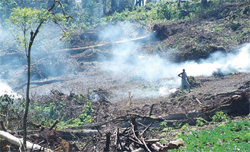Mau Forest Saga: People Must Pay their Environment Bills
Published on 28th July 2009
 |
| Besieged Mau Forest Photo courtesy |
Way back in 2006, I took a Swiss lady for hunting deep in the remaining shrubs of western
Kenya. You guessed wrong; we were hunting for the "eye of a river!" An investment banker, she was interested in touching the real source of a river in
Kenya, and there it was, a tiny seepage of cool clean water! "You know what; you are touching one of the very many sources of River Nile..." I exclaimed. The tiny rivulet, weaves itself through the undergrowths in Osichilo area to River Lusumu, which in turn supplies
Lake Victoria, the main reservoir for River Nile.
While sailing over the Nile early this year, I told my Egyptian hosts about our "hunting" expedition for the "eye of the river." It is amazing when one ponders the interconnectedness of human actions. Sailing on the Nile in Cairo ceases to just give a pleasant holiday feeling but brings to focus the activities of hundreds of thousands of people that toil to feed themselves thereby impacting on a Nile Cruise. To ignore such a population, is to expose the "eye" to extinction.
The ongoing Mau Forest Complex environmental debate in Kenya offers a simple lesson; people must pay their environmental bills! Environmentalists refer to the originally 988,000 acre forest complex as a "water tower" that feeds both the Lake Victoria region and lakes in parts of Rift Valley. Reports attributable to a task force appointed by Kenya's Prime Minister estimate that this forest complex supports an economy of over $US 300 Million annually in Kenya alone.
Instead of politicizing this issue; our leaders ought to focus on seeking a long lasting solution. It is important that all concerned parties connect the "eye of the river" to Egypt! In that case, the best option ought to be to devise a strategy to pay Kenyans to conserve forests and other strategic environmental assets. Another approach ought to be to focus on policies that hold the majority in poverty. The concoction of majority in poverty and minority in extreme wealth bred by bad policies pushes individuals to focus on short term survival tactics that threaten balance in the ecosystem.
Kenyans for example pay their bills for the conservation of Mau Forest indirectly through electricity rates; town council water rates; tourism rates for flamingoes and wildebeest migration; good health (due to clean air) and cooler climate (because trees act as carbon sinks) among other benefits. My take is that, the Kenyan citizens who are presently vilified for destroying the forest are victims of "it belongs to all of us economics." Such an economic system benefits a few who will always act as tribal chiefs whose bellies are overloaded with national cake goodies.
Instead of blaming the victims in the Mau forest saga; we ought to advance arguments such as; how much should we pay those who occupy this strategic complex so as not to engage in certain economic activities that jeopardize Kenya's and by extension Africa's livelihood? The Ogiek community that have for decades been pre-occupied with hunting and gathering, for example, ought not to be seen as primitive.Rather, a monthly pay check ought to come from those whose economic livelihood directly depends on keeping a strategic complex in place. If the Kenya government (that is Kenyan citizens) commits to pay people who protect environmental assets; the percentage of the country's forest cover will increase in no time. The same can be said for Africa in general.
While participating in a European Landowners' Organization workshop early this year, I was amazed at how the Westerners measure almost everything and calculate payment for "public goods." From a simple premise "Who pays the entry fee for enjoying the environment?" ...arguments have been advanced to the effect that those who protect forests such as those in Brazil ought to be paid. The Carbon Credits or payments for carbon offset stems from this idea. In part, that is why Africa's clamor to push Europeans to lower agricultural subsidies to farmers always hit the wall; Europeans are ahead and will simply use "crops clean environment argument" to keep their subsidy in place.
The Mau saga reveals the dangers of "Mali ya Umma," (loosely translated to "it belongs to all of us or the public") a mentality that has been creating tyranny in Kenya. The very politicians we expect to offer a solution are the same characters hiving off huge pieces of land for themselves and even leasing out some to foreigners. In both cases, the common mwananchi (citizen) is treated as though he/she cannot add any value to the society. What belongs to all of us belongs to no one and so falls into disrepair - Mau is a typical example.
If policy makers genuinely recognized the importance of this so called water tower and opted to pay people staying in and around this complex; there will be no need of environmental activism. Kenyan and by extension Africa opinion leaders and experts ought to use this Mau saga to develop measurements on the value the ecosystem adds to the economy. Such measurements can be used to develop compensation rates for individuals/communities that offer public goods such as protecting forests, wildlife conservation, and flowers for bees among others. Experts from U.S.A, Netherlands and Argentina estimated in 1997 that the ecosystem offers USD 33 trillion worth of service to global GNP.
It is clear that development policies in Africa ought to go beyond individual countries and focus on people and how their activities are interconnected. To conserve the Mau forest and other strategic ecosystems on the continent, those consuming the benefits must be ready to pay their bill.
By James Shikwati
Mr James Shikwati james@irenkenya.org is Director, Inter Region Economic Network
This article has been read 3,571 times


